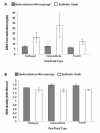Assessing genetic polymorphisms using DNA extracted from cells present in saliva samples
- PMID: 22182470
- PMCID: PMC3267685
- DOI: 10.1186/1471-2288-11-170
Assessing genetic polymorphisms using DNA extracted from cells present in saliva samples
Abstract
Background: Technical advances following the Human Genome Project revealed that high-quality and -quantity DNA may be obtained from whole saliva samples. However, usability of previously collected samples and the effects of environmental conditions on the samples during collection have not been assessed in detail. In five studies we document the effects of sample volume, handling and storage conditions, type of collection device, and oral sampling location, on quantity, quality, and genetic assessment of DNA extracted from cells present in saliva.
Methods: Saliva samples were collected from ten adults in each study. Saliva volumes from .10-1.0 ml, different saliva collection devices, sampling locations in the mouth, room temperature storage, and multiple freeze-thaw cycles were tested. One representative single nucleotide polymorphism (SNP) in the catechol-0-methyltransferase gene (COMT rs4680) and one representative variable number of tandem repeats (VNTR) in the serotonin transporter gene (5-HTTLPR: serotonin transporter linked polymorphic region) were selected for genetic analyses.
Results: The smallest tested whole saliva volume of .10 ml yielded, on average, 1.43 ± .77 μg DNA and gave accurate genotype calls in both genetic analyses. The usage of collection devices reduced the amount of DNA extracted from the saliva filtrates compared to the whole saliva sample, as 54-92% of the DNA was retained on the device. An "adhered cell" extraction enabled recovery of this DNA and provided good quality and quantity DNA. The DNA from both the saliva filtrates and the adhered cell recovery provided accurate genotype calls. The effects of storage at room temperature (up to 5 days), repeated freeze-thaw cycles (up to 6 cycles), and oral sampling location on DNA extraction and on genetic analysis from saliva were negligible.
Conclusions: Whole saliva samples with volumes of at least .10 ml were sufficient to extract good quality and quantity DNA. Using 10 ng of DNA per genotyping reaction, the obtained samples can be used for more than one hundred candidate gene assays. When saliva is collected with an absorbent device, most of the nucleic acid content remains in the device, therefore it is advisable to collect the device separately for later genetic analyses.
© 2011 Nemoda et al; licensee BioMed Central Ltd.
Figures



References
-
- Koni AC, Scott RA, Wang G, Bailey ME, Peplies J, Bammann K. et al.DNA yield and quality of saliva samples and suitability for large-scale epidemiological studies in children. Int J Obes (Lond) 2011;35:S113–118. - PubMed
-
- Ochert AS, Boulter AW, Birnbaum W, Johnson NW, Teo CG. Inhibitory effect of salivary fluids on PCR: potency and removal. PCR Methods Appl. 1994;3:365–368. - PubMed
MeSH terms
Substances
LinkOut - more resources
Full Text Sources
Miscellaneous

